Land Rover began in 1947 with the Series I and continued until 1985 manufacturing the Series III model. This identification was initiated by Land Rover as a means of identifying major design changes in production. They did not intend to change them on an annual basis. The designers felt that they had this "agricultural workhorse" so right from the start, that annual cosmetic styling would only detract from its functional applications.
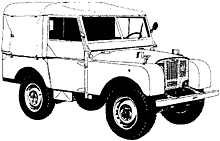 |
1) Land Rover Series I, 80" 1948-1953
May 1950, headlamps protrude through grille. Mid 1951, inverted "T" grille (as Series II's). Side lights move from bulkhead to wings. Pre mid 1951 models for U.S. market had bulkhead lights relocated to wings to comply with lighting regulations. 1949-1951 Tickford Coachbuilders produced 650 Station Wagons. |
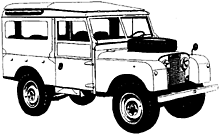 |
2) Land Rover Series I, 86" 1953-1957. Station Wagon
A redesigned vehicle with increased load space. Wheel base lengthened to 88" 1957-1958 to accommodate new engine. |
 |
3) Land Rover Series I, 107" 1953-1957, Pick-up with 3/4 canvas
Same design as basic 80" with much larger load space. Wheel base lengthened to 109" 1957-1958 to accommodate new engine. |
 |
4) Land Rover Series I, 107" 1956-1958, Station Wagon
Redesigned rear body with doors and seating for additional passengers. |
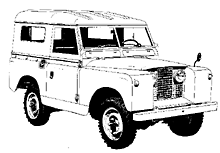 |
5) Land Rover Series II, 88" 1958-1961, Hard Top
New body style, includes sill panels to conceal chassis, fuel tank exhaust pipe. Available as pick-up, soft top and station wagon. |
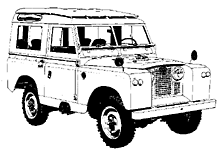 |
6) Land Rover Series II 88" 1958-61 Station Wagon
Station Wagon had a full hard top with tropical roof, sliding windows, fresh air vents and alpine windows. Rear door and full interior trim with seating for 7 people. |
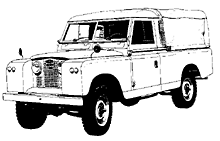 |
7) Land Rover Series IIA, 109", 1961-1971, Pick-up with 3/4 canvas
The "regular" or "two door" 109" was available in North America in Series II and IIA from 1958 to 1966. Petrol or diesel engine. |
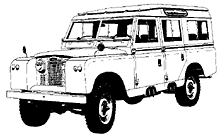 |
8) Land Rover Series IIA, 109", 1961-1971 Station Wagon
Originally a 10 seater it was "re-launched" as a 12 seater to "get around" British tax laws. 2.6 litre 6 cylinder petrol engine was introduced in 1967. The 109" SW was available in North America in Series II and IIA form from 1958-1967. |
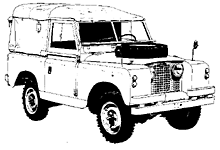 |
9) Land Rover Series IIA, 88" 1961-1971, Military Soft Top
Designated "1/4 ton" in British military service. Available as a "general service" vehicle with 12v electrics or a "fitted for radio" vehicle with 24v electrics. |
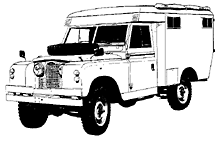 |
10) Land Rover Series IIA, 109", 1961-1971 Military Ambulance
Custom built rear body built by Marshals of Cambridge. In addition to regular military specs. These vehicles had front and rear sway bars. |
 |
11) Land Rover Series IIA, 109", "Dormobile" Conversion
Molded fiberglass, side hinged roof section, opens for added head room and loft sleeping space. Interior fitted with special seats, sink, cabinets and stove. Some vehicles had side lights mounted atop wings so that fuel and water cans could be carried atop the front bumper. |
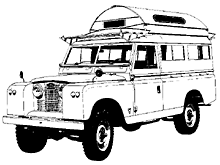 |
12) Land Rover Series IIA, 109", "Carawagon" Conversion
Competitor to the Dormobile, this camper conversion uses wood to extend the standard roof, usually fitted to a regular 109"'. |
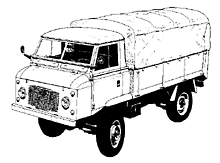 |
13) Land Rover Forward Control Series IIA, IIB 1961-1970
Utilized many of the same mechanical components, like engines, as normal Land Rovers. Massive 5'4" x 10'5" load bed was rated for a 3,380 lb. load. Ideal for special purpose platforms, many were fitted with hinged drop sides and tailgate. Removable corner posts allowed it to convert to a flatbed in minutes. |
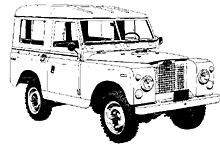 |
14) Land Rover Series IIA 88" 1969 "Bugeye"
Lighting regulation in Australia required moving the headlamps from the radiator panel to the wings. Land Rover had not yet designed a proper panel to accept the lights. So they sat on the surface. This interim model, between the so-called "early" IIA and "late" IIA is commonly referred to as the "Bugeye" .
|
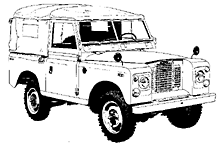 |
15) Land Rover Late Series IIA, 88", Fall 1969-1971, Soft Top
New front wing panels with recessed headlamp. Available as hard top, station wagon and pick-up model. 2 1/4 litre petrol or diesel engine. Sill panels narrowed from 5" to 3".
|
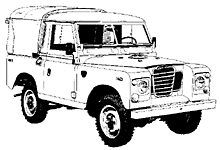 |
16) Land Rover Series III, 88", Fall 1971-1985 Pick-up with 3/4 canvas
Plastic radiator grille replaces wire mesh type. Revised instrumentation - moved from central position to in front of driver with plastic dash. Available in U.S.A. as hard top seven seater through 1974. |
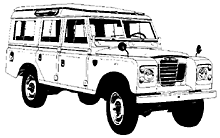 |
17) Land Rover Series III, 109", Fall 1971-1985 Station Wagon
Produced in 10 and 12 passenger configuration. 2 1/4 petrol, 2 1/4 diesel and 2.6 petrol engines. V8 available in 1980. Tropical roof with air vents. |
 |
18) Land Rover Series III, 109", 1971-1985 3/4 Ton Regular
Military Soft Top Reinforced body and chassis with two inch suspension extension. Standard equipment included oil cooler, twin fuel tanks, military waterproof lighting system, front and rear bumperettes with lifting rings. Available in 12v GS (general service) and 24v FFR (fitted for radio).
|
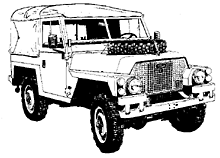 |
19) Land Rover Series III 88" 1971-1985 Military Lightweight
Series IIA version 1968-1971. The early IIA Lightweights had their F.V. headlamps mounted on the radiator panel. Late IIA and III models had theirs on the wings. Designated "1/2 ton", it was designed to be air lifted by helicopter. The standard 1/4 ton was too heavy, the Lightweight heavier still, but it could be rapidly stripped of necessary panels to bring it within the helicopter's lifting capabilities. |
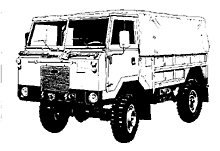 |
20) Land Rover Military 101" Forward Control 1974-1978
Designated "1 Ton" by British Military. Powered by a 3.5 litre V8, minimal front and rear overhang made it Solihull's most capable performer off road. Designed as a gun-tractor for the new British 105mm light gun which weighed 750 lbs more than the 105mm Pack Howitzer towed by the "3/4 ton" 109". Also available in hard top and Ambulance versions. |
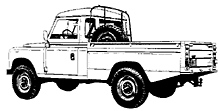 |
21) Land Rover Series III, 109", High Capacity Pick-Up (H.C.P.U.)
1981-1983. Redesigned rear body for carrying loads of greater volume wider and longer load areas is separated from cab. Incorporates a full width tailgate. Replaced in late '83 by the 110" H.C.P.U. |
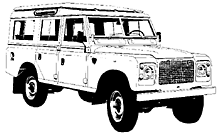 |
22) Land Rover Series III, 109", Stage One V8, Station Wagon 1979-1985
So named as they were "Stage 1" of a major investment scheme in 1978. 3.5 litre V8, using Range Rover gearbox and permanent 4WD. Radiator grille moved forward and new bonnet fitted to accommodate larger drive train. Available in all 109" body styles. |
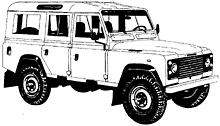 |
23) Land Rover 110 Station Wagon 1983-Present
Introduction of coil spring suspension as used in the Range Rover. Styling changes include one piece windscreen with new roof design and wheel arches added to the wings to accommodate wider track. |
 |
24) Land Rover 90 Station Wagon 1984-Present
Uses same engine and transmission as the 110. 92.9" inch wheel base. |
 |
25) Land Rover 130, Crew Cab, High Capacity Pick-up 1991-Present
Introduced in 1985. A 127" wheel base version of the 110". Aimed at commercial markets, it is ideally suited for special body conversions. Also offered in six wheel drive. After manufacturer most 130's are finished at Land Rover's Special Vehicle Operations facility at Solihull. Here 130's are completed to the owners custom design and specification.
|
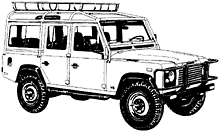 |
26) Land Rover Defender 110 Station Wagon U.S.A. Model 1993
Limited edition. 500 vehicles sold in the United States. Featured a 3.9 litre V8 with a 5 speed gearbox and permanently mounted external rollcage. |
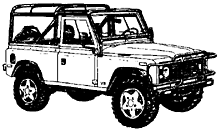 |
27) Land Rover Defender 90 Soft Top U.S.A. Model 1994-1997
3.9 litre with 5 speed or 4.0 litre with automatic gearbox.
|
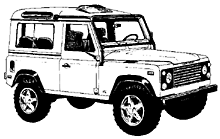 |
28) Land Rover Defender 90 Station Wagon U.S.A. Model 1995 and 1997
'95 Limited edition of 500 . 1997 4.0 litre with automatic gear box. |